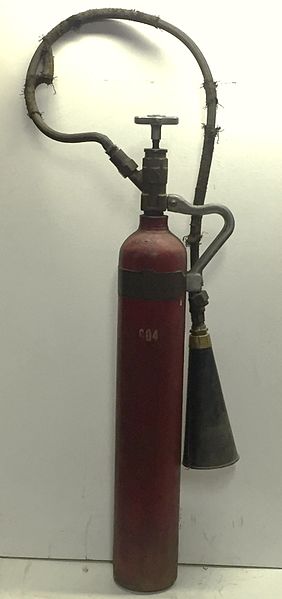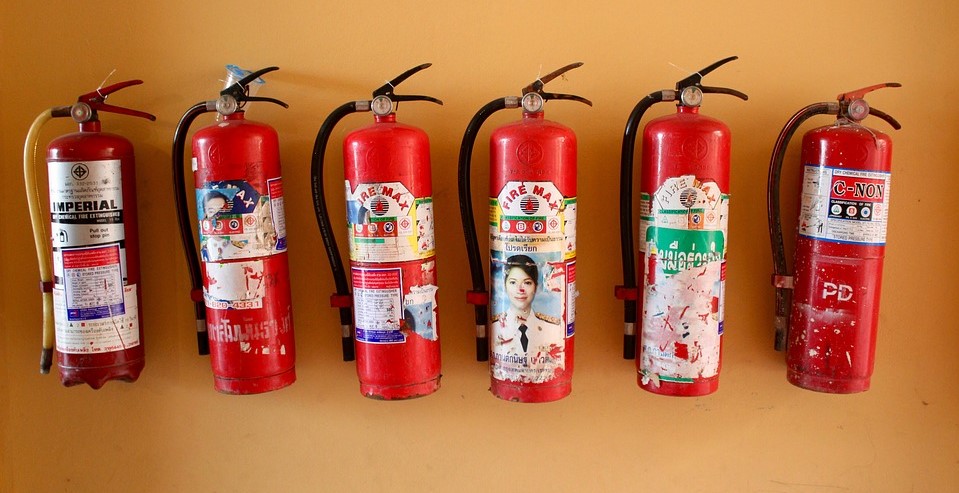Fire extinguisher
Contents |
[edit] Introduction
Fire extinguishers are portable apparatus used to put out small fires in emergency situations. They work by distributing a suitable extinguishant (such as liquid, foam, powder and so on) onto the burning material to cut off its supply of oxygen or suppress the chemical reaction occurring in the flame.
[edit] History
The earliest forms of fire extinguisher were introduced in the Middle Ages. These devices, known as squirts, were pump-like devices with nozzles on the end.
The nozzle of the pump would be put into water, and a plunger would be used to pull the water into the squirt. The nozzle was then aimed at the fire, and the water stream would be directed towards the fire.
In 1723, Ambrose Godfrey was awarded the first official patent for a fire extinguisher. The German-born British chemist was best known for his production of phosphorus, but in 1724, he published a document entitled ‘New Method of Extinguishing Fires by Explosion and Suffocation’. His idea was to design a machine consisting of a cask of an aqueous solution surrounding a pewter chamber of gunpowder. The idea behind this was that a series of fuses would be detonated which would then make the gunpowder explode and distribute the liquid.
The first portable fire extinguisher was invented in 1819 by Captain George William Manby. His device consisted of a copper vessel containing a solution of potassium carbonate and compressed air.
Other early examples included:
- 1866 sodium bicarbonate and sulphuric acid with water
- 1904 chemical foam of sodium bicarbonate and aluminium sulphate.
- 1912 carbon tetrachloride (CTC).
- 1924 carbon dioxide.

|
| The 1924 carbon dioxide extinguisher invented by the Walter Kidde Company was made to put out fires in telephone switchboards. The device consisted of a metal cylinder with a wheel valve and a brass hose covered with cotton. The extinguisher in this photograph was made by the Walter Kidde Company for Bell Telephone in 1928. |
[edit] Fire extinguisher categories
In the UK, fire extinguishers are included in the standard BS EN 3 - Portable fire extinguishers. The extinguishers are colour coded to indicate which type of fires they should be used to extinguish:
- Water = Red
- Foam = Red with cream panel above the operating instructions
- Dry powder (generally a mix of monoammonium phosphate and ammonium sulfate, but not for combustible fires) = Red with blue panel above the operating instructions
- Carbon dioxide = Red with black panel above the operating instructions.
- Wet chemical (generally containing potassium acetate with potassium citrate or potassium bicarbonate) = Red with a bright yellow panel above the operating instructions.
- Class D powder (generally a mix of monoammonium phosphate and ammonium sulfate, but only for combustible fires) = Red with blue panel above the operating instructions.
[edit] Six fire classes
The UK recognises six fire classes:
- Class A fires involve organic solids such as paper and wood.
- Class B fires involve flammable or combustible liquids, including petrol, grease and oil.
- Class C fires involve flammable gases.
- Class D fires involve combustible metals.
- Class E fires involve electrical equipment/appliances.
- Class F fires involve cooking fat and oil.
| Class A | Class B | Class C | Class D | Class E | Class F | |
| Water | Yes | |||||
| Foam | Yes | Yes | ||||
| Dry powder | Yes | Yes | Yes | Yes | ||
| Carbon dioxide | Yes | Yes | ||||
| Wet chemical | Yes | Based on situation | Yes | |||
| Class D powder | Yes |
While the powder inside fire extinguishers is non-toxic, contact should be limited. Precautions should be taken to minimise incidents where these circumstances could occur.
[edit] Maintenance
Fire extinguishers should be checked and maintained on a regular basis. While it’s uncommon for a device to have an expiration date, its reliability can degrade over time if it has not been properly maintained.
In the UK, there are three types of required maintenance:
- Basic. Annual service and inspection
- Extended. Five year test discharge and recharge.
- Overhaul: 10 year test for CO2 extinguishers.
[edit] Related articles on Designing Buildings Wiki
Featured articles and news
One of the most impressive Victorian architects. Book review.
Common Assessment Standard now with building safety
New CAS update now includes building safety questions as mandatory.
RTPI leader to become new CIOB Chief Executive Officer
Dr Victoria Hills MRTPI, FICE to take over after Caroline Gumble’s departure.
Social and affordable housing, a long term plan for delivery
The “Delivering a Decade of Renewal for Social and Affordable Housing” strategy sets out future path.
A change to adoptive architecture
Effects of global weather warming on architectural detailing, material choice and human interaction.
The proposed publicly owned and backed subsidiary of Homes England, to facilitate new homes.
How big is the problem and what can we do to mitigate the effects?
Overheating guidance and tools for building designers
A number of cool guides to help with the heat.
The UK's Modern Industrial Strategy: A 10 year plan
Previous consultation criticism, current key elements and general support with some persisting reservations.
Building Safety Regulator reforms
New roles, new staff and a new fast track service pave the way for a single construction regulator.
Architectural Technologist CPDs and Communications
CIAT CPD… and how you can do it!
Cooling centres and cool spaces
Managing extreme heat in cities by directing the public to places for heat stress relief and water sources.
Winter gardens: A brief history and warm variations
Extending the season with glass in different forms and terms.
Restoring Great Yarmouth's Winter Gardens
Transforming one of the least sustainable constructions imaginable.
Construction Skills Mission Board launch sector drive
Newly formed government and industry collaboration set strategy for recruiting an additional 100,000 construction workers a year.
New Architects Code comes into effect in September 2025
ARB Architects Code of Conduct and Practice available with ongoing consultation regarding guidance.
Welsh Skills Body (Medr) launches ambitious plan
The new skills body brings together funding and regulation of tertiary education and research for the devolved nation.
Paul Gandy FCIOB announced as next CIOB President
Former Tilbury Douglas CEO takes helm.
























